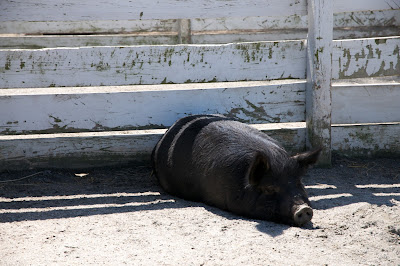 |
| Pic via wikipedia commons |
Description
 |
| Guinea Hog at the Roger Williams Zoo park (pic via wikipedia commons). |
The Guinea hog weighs only 150-300 pounds, and twenty-two to twenty-seven inches high, making it much smaller than your average farm pig! This breed is solid black in color, the only exceptions being white-tipped feet, and the very rare and recessive red. They also have longer, thicker hair than most pigs, allowing them to avoid sunburn and handle weather well. One of the most notable aspects of the American Guinea Hog is their ability to forage. The hogs can live off of much poorer quality forage than most breeds of pig, giving them the potential to be very valuable on a homestead. Another excellent quality of this breed is their calm temperament! They are known for being easy to handle, even adult males and females with piglets! They are known to be attentive mothers, rearing healthy, hardy young and raising them to forage themselves.
Guinea Hogs are generally processed at around six months of age, and the carcass can range from 50-100 pounds. The meat of the Guinea Hog is often considered gourmet, as the unique texture of their fat as sparked interest in making old-world cured meats. Their meat is also known to be very tender and flavorful!
Origin and History
While its exact origins are somewhat unclear, it appeared during the 19th century and evidence suggests that is was bred from the Essex, an English breed of hog that, like the Guinea Hog, is small and black in color. It is often mistaken to have been related to the Red Guinea, a hog that was imported to the US from the Canary Islands. Despite the similar name, the American Guinea Hog has no relation to the Red Guinea Hogs that were originally imported. It is likely that the "Guinea" in the name refers to the animal's small size.
This hardy breed was and commonplace on American farms during the nineteenth century, and it was expected to forage for their own food, eating roots, reptiles, and rodents. Families would often keep them near the house to clear the area of snakes - a favorite food of the hogs. As time went on, fewer and fewer Americans were living on homesteads, and the American Guinea Hog nearly disappeared. It lived on in only a few isolated farms throughout the Southeastern US, and has made a recent comeback with rise in popularity of homesteading and small-scale farming. It is listed by The Livestock Conservancy as "threatened," although more and more people are discovering the potential of this perfect pig and making the addition!
On Your Homestead
 |
| American Guinea Hog at Norfolk Zoo (pic via wikipedia commons). |
The Guinea Hog is the ultimate pig for homesteaders, preppers, and hobby farmers. Their small size and gentle demeanor allows for easily handling, which is especially important if there are children involved. The fact that this breed can thrive by foraging for food, even in places where it may not be the highest quality, makes the Guinea Hog extremely valuable to someone who is trying to be as self sufficient as possible. When forage is not available, such as in the winter months, they can live largely off of food scraps from the family. This is where their small size comes into play, as a smaller pig doesn't require as much food. Pound-for-pound, the Guinea hog is capable of producing a lot of meat with little cost to the farmer. They are the most ideal pig for a free-range setting, hands-down!
Care must be taken not to overfeed a Guinea Hog, particularly grain, because they are designed for foraging and have a tendency to become overweight when fed a rich diet.
Some homesteaders have found a new use for the hogs - tilling and fertilizing the garden. The pigs can be placed in an area that needs tilled, such as a place where grain had been planted and harvested as a cover crop, and the pigs turn up the ground as the forage through what is left of the crop. When the hogs are finished, they leave plant-ready ground!
Where to get Guinea Hogs
Guinea Hogs are becoming easier to find! I've seen several people selling them on local sale pages on Facebook! If you wish to breed, however, it is best to invest in quality stock to contribute to bringing the breed back! The American Guinea Hog Associated has a directory of breeders in the US. There are breeders in nearly every state! If you simply wish to have them for your own homestead, scour local livestock ads and online classifieds. There is likely a farmer near you that has them!
Do you have Guinea Hogs? Or are you just thinking about adding pigs to your homestead? Leave a comment! Don't forget to check out our Facebook page and our Instagram for updates and pictures!
Sources:
"The Livestock Conservancy." The Livestock Conservancy. N.p., n.d. Web. 28 Aug. 2016. <https://livestockconservancy.org/index.php/heritage/internal/guineahog>.
"History of Guinea Hogs -." AGHA. American Guinea Hog Assn., 2006. Web. 28 Aug. 2016. <http://guineahogs.org/history-of-guinea-hogs/>.
"American Guinea Hog Breed Description -." AGHA. American Guinea Hog Assn., 2006. Web. 28 Aug. 2016. <http://guineahogs.org/american-guinea-hog-breed-description/>.
OHM, Rachel. "Farmers and Rare Guinea Hogs Help Each Other out - The Portland Press Herald / Maine Sunday Telegram." The Portland Press Herald Maine Sunday Telegram Farmers and Rare Guinea Hogs Help Each Other out Comments. MaineToday Media, 07 Sept. 2014. Web. 28 Aug. 2016. <http://www.pressherald.com/2014/09/07/farmers-and-rare-guinea-hogs-help-each-other-out/>.

No comments:
Post a Comment